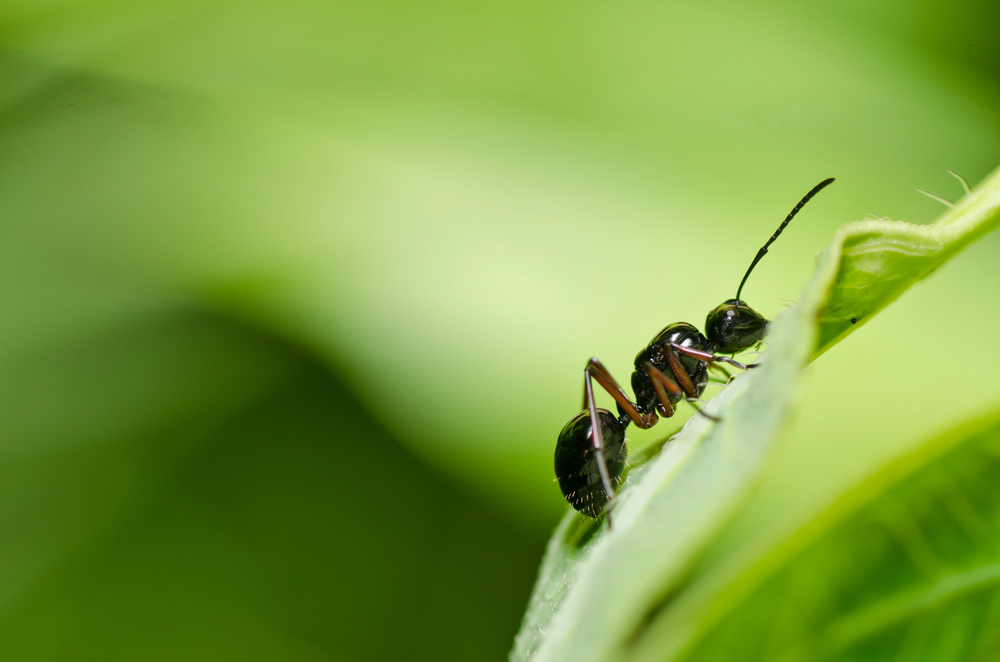Ants can quickly turn a well-kept lawn into uneven ground covered with soil mounds. These nests disrupt the grass surface, affect mowing, and in some cases damage the roots.
The most effective way to get rid of ants in a lawn is to treat the entire affected area with a proven method such as nematodes, diatomaceous earth, or a targeted insecticide, depending on the situation.
While ants can help aerate soil, large colonies can cause visible damage and make the lawn unpleasant to use. Identifying the extent of the infestation and choosing the right control method prevents wasted effort and protects surrounding plants, pets, and wildlife.
A clear plan will address both the active nests and the conditions that encourage ants to return. By combining treatment with simple lawn care adjustments, it is possible to restore a smooth, healthy surface and keep ant populations under control over the long term.
Understanding Ants and Their Impact on Lawns
Ant colonies in lawns can influence soil structure, grass health, and the overall appearance of turf. Their nesting habits may benefit soil aeration, but excessive activity often creates uneven ground and damages grass surfaces.
Common Types of Ants Found in Lawns
In the UK, the most common lawn ant is the black garden ant (Lasius niger). Colonies can contain thousands of workers and a single queen, making them persistent once established.
Yellow meadow ants (Lasius flavus) are also present, though they spend more time underground and are less visible. Their mounds are often dome-shaped and covered in grass.
Red ants (Myrmica spp.) are less frequent but can deliver a mild sting. They prefer sunny, dry areas and may build nests along lawn edges. Identifying the species matters because their behaviour and control methods differ.
How Ants Build Ant Hills and Nests
Ant nests are created through extensive tunnelling. Workers excavate soil and bring it to the surface, forming ant hills that can range from a few centimetres to several inches high.
These mounds protect the nest entrances and help regulate temperature and humidity inside the colony. The tunnels beneath can extend deep into the soil, often reaching plant root zones.
In dry weather, some species expand their nests further to seek moisture. Over time, this activity can loosen the soil, making it unstable and uneven for mowing or walking.
Effects of Ant Infestations on Lawn Health
Small ant populations rarely cause lasting harm to grass. In fact, light tunnelling can improve soil aeration. Problems occur when colonies grow large and mounds disrupt the lawn surface.
Raised mounds can scalp under mower blades, exposing or tearing grass roots. This damage can lead to bare patches that are slow to recover.
Heavy infestations may also disturb root systems, especially in sandy or dry soils. While ants do not feed on grass, their nesting activity can indirectly weaken turf and create entry points for weeds. In such cases, targeted control becomes necessary to restore an even and healthy lawn surface.
Proven Methods to Get Rid of Ants in Your Lawn
Effective ant control in lawns involves targeting the colony directly, reducing food sources, and using treatments that do not harm grass. Some methods rely on biological control, while others involve physical or chemical approaches.
Using Nematodes for Organic Ant Control
Beneficial nematodes, such as Steinernema feltiae, are microscopic worms that attack soil-dwelling insects, including ants. They enter the ant larvae and release bacteria that kill the host within days.
These nematodes are applied by mixing them with water and spraying over the affected lawn area. They work best in moist soil and mild temperatures, as extreme heat or dryness can reduce their effectiveness.
For best results, the lawn should be watered before and after application to help nematodes move through the soil. They are safe for people, pets, and beneficial insects, making them a suitable choice for organic lawn care.
Reapplication may be needed if ant populations persist, as nematodes naturally decline over time.
Applying Diatomaceous Earth Safely
Diatomaceous earth (DE) is a fine powder made from fossilised algae. It kills ants by damaging their exoskeleton, which causes dehydration. It is most effective in dry weather, as moisture reduces its abrasive action.
To apply, sprinkle food-grade DE directly over ant trails, nest entrances, and surrounding soil. Avoid using it before rain or irrigation, as water will make it clump and lose effectiveness.
Wearing PPE such as gloves and a dust mask is recommended, as the fine particles can irritate the skin and lungs. DE is non-toxic to humans and animals when used correctly, but it should be kept away from water sources to prevent contamination.
Reapply after rain or heavy dew to maintain control.
Selecting and Using Lawn-Safe Insecticides
Lawn-safe insecticides can provide faster results for severe infestations. Granular or liquid formulations containing active ingredients like bifenthrin or permethrin are common choices.
These products should be applied according to the manufacturer’s instructions to avoid damaging grass or harming non-target species. Spot-treating ant mounds can limit chemical exposure while still targeting the colony.
When using insecticides, PPE such as gloves, long sleeves, and eye protection should be worn. Pets and children should be kept off treated areas until the product has dried or been watered in.
Rotating between different active ingredients can help prevent resistance in ant populations.
Addressing Ant Nests and Repairing Lawn Damage
Ant nests disturb soil structure, create uneven surfaces, and can weaken grass growth. Removing the nest and repairing the affected area restores lawn health and prevents further deterioration.
Locating and Disrupting Ant Nests
To remove ants effectively, the nest’s main entrance and activity zones must be found. Fresh ant hills often appear as loose, dry mounds of soil with visible worker ants moving in and out.
Observation during early morning or late evening helps, as more ants are inside the nest. Following trails to their source can confirm the central location.
Once located, disruption methods include pouring boiling water directly into the openings, applying diatomaceous earth, or using lawn-safe ant baits. These approaches target the colony and reduce the chance of it relocating nearby.
Digging Up Ant Hills
In some cases, physical removal is the most direct option. Using a garden spade or fork, the soil mound can be lifted and broken apart. This exposes tunnels and chambers, making it harder for ants to rebuild.
For larger hills, removing several inches of surrounding soil may be necessary to reach the queen’s chamber. Care should be taken to avoid spreading ants to other lawn areas during the process.
After removal, the soil should be raked level to prevent mower damage and to prepare the ground for reseeding. If chemical treatments are used beforehand, allow time for them to take effect before digging.
Restoring Lawn After Ant Removal
Once the nest is cleared, the damaged patch often needs repair to restore a smooth, healthy surface. Start by filling any depressions with a mix of topsoil and fine sand to match the surrounding soil texture.
Firm the area lightly, then overseed with a grass variety that matches the existing lawn. Keep the seedbed moist until germination occurs.
In cases of severe thinning, applying a balanced lawn feed can help new grass establish quickly. Regular mowing, watering, and aeration will strengthen the repaired section and make it less attractive to ants in future.
Preventing Future Ant Infestations in Lawns
Keeping ants from returning requires consistent lawn care, control of insect food sources, and support for natural predators. A healthy lawn with balanced soil and reduced pest activity is less attractive for ant colonies.
Lawn Maintenance Practices to Deter Ants
Regular mowing keeps grass short, which limits shaded areas where ants can nest. Trimming shrubs and clearing fallen leaves or branches removes shelter and reduces moisture build-up.
Aerating compacted soil improves drainage, making the ground less appealing to ants that prefer damp conditions. Overseeding bare patches helps grass outcompete weeds and reduces open soil for nesting.
Repairing leaky irrigation systems or outdoor taps prevents water pooling, which can attract both ants and the insects they feed on. Consistent lawn care lowers the likelihood of ant infestation.
Managing Aphids and Honeydew
Aphids can indirectly increase ants in lawns. They feed on plants and excrete honeydew, a sugary substance that attracts ants. Ants often protect aphids from predators to maintain this food source.
Inspect plants for signs of aphids, such as curled leaves or sticky residue. Washing them off with a strong stream of water or applying insecticidal soap can reduce their numbers.
Avoid over-fertilising, as excessive nitrogen can encourage aphid growth. By lowering aphid populations, the honeydew supply diminishes, making the area less appealing for ant colonies.
Encouraging Natural Predators
Predatory insects and birds can help control ants and related pests. Ladybirds, lacewings, and certain beetles feed on aphids, reducing the honeydew that draws ants.
Planting nectar-rich flowers can attract beneficial insects that prey on pests. Providing bird feeders and water sources can encourage species that naturally hunt ants.
Avoid broad-spectrum insecticides where possible, as these can harm predators and disrupt the balance of the lawn ecosystem. Supporting these natural controls helps keep ant populations in check without constant chemical treatments.





